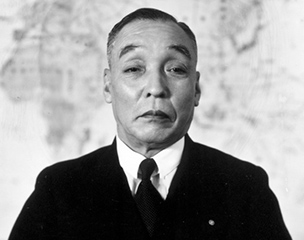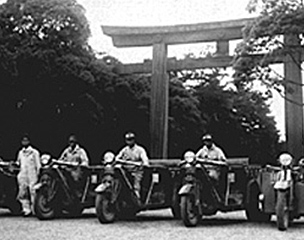Mazda-Go 3-wheeled trucks(1931~)
The original Mazda vehicles: Mazda-Go three-wheeled trucks
Mazda's history as an automaker began in 1931 with the unveiling of a three-wheeled truck known as the Mazda-Go Type-DA. The company was aiming for class-leading performance and maximum loading capacity, domestic production of various parts including the engine, and the setting up of a consistent volume production system. The engine was built in-house and had a transmission with a reverse gear, a rear differential and other components patented by Mazda(then Toyo Kogyo). The introduction of the Mazda-Go was a pivotal moment in the history of Japan's three-wheeled truck market.
Japan's automotive history began with Mitsubishi Shipbuilding, Ltd. (currently Mitsubishi Motors) which commenced production of its Mitsubishi A Type passenger car in 1917. Nissan, in its previous form was established as an automaker in 1933, Toyoda Automatic Loom Works, Ltd. (currently Toyota) completed its A1 Type passenger car in 1935, and Honda was established later in 1946. In this historical context, Mazda was an early starter in automobile manufacturing compared with other Japanese companies.
The Mazda brand name was born with the three-wheeled truck
The name Mazda came into existence with the production of the Company's first three-wheeled trucks. Other candidates for a model name included Sumera-Go, Tenshi-Go and more. But these were swept aside when it was decided to name it in honor of the family name of then company president, Jujiro Matsuda. The name was also associated with Ahura Mazda (God of Light), with the hope that it would brighten the image of these compact vehicles. The Mazda lettering was used in combination with the corporate emblem of Mitsubishi, which was responsible for sales, to produce the Toyo Kogyo three-wheeled truck registered trademark.

Jujiro Matsuda
Kagoshima-Tokyo caravan advertising campaign travels over 2,700 kilometers
Mazda was seriously involved in advertising activities from early on. The company took the lead in this with its 1936 Kagoshima-Tokyo Caravan Campaign. With four Mazda-Go Type-KC and one Mazda-Go Type-DC vehicles on the road, the caravan covered over 2,700 kilometers between Kagoshima and Tokyo in 25 days, in an effort to promote excellence and reliability to customers. The caravan campaign contributed enormously to the increased sale of Mazda vehicles. This first foray into the three-wheeled truck business later turned into a three-wheeled truck caravan boom. In the post-war era of 1950, Mazda began selling the Type-CA one-ton truck powered by a 1,157 cc engine, and from there went on to build passenger vehicles.

Kagoshima-Tokyo caravan

